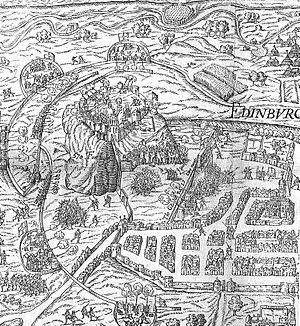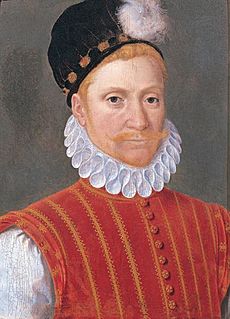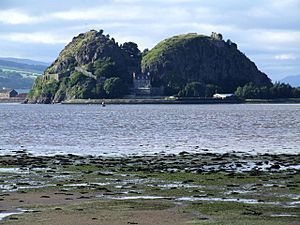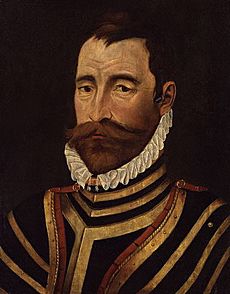Marian civil war facts for kids
Quick facts for kids Marian Civil War |
|||||||
|---|---|---|---|---|---|---|---|
| Part of the European wars of religion | |||||||
 Woodcut of the Siege of Edinburgh Castle held for Mary in 1573, from Holinshed's Chronicles (1577) |
|||||||
|
|||||||
| Belligerents | |||||||
| Commanders and leaders | |||||||
The Marian Civil War in Scotland (1568–1573) was a time of fighting. It began after Mary, Queen of Scots, gave up her throne. She then escaped from Lochleven Castle in May 1568.
People who supported her young son, James VI, fought against Mary's followers. Mary was living in England at this time. Edinburgh Castle became a key place in the war. It was held by Mary's supporters and only gave up after England stepped in during May 1573. People at the time called it a "war in the heart of this country."
Contents
Who Fought: Queen's Men vs. King's Men
Mary, Queen of Scots, had many supporters. They believed she was the rightful queen. They felt she had been unfairly removed from her throne.
The King's supporters said they were fighting for the Protestant religion. They saw their fight as similar to religious wars happening in France. Mary had escaped from prison and joined her main supporters. But they were defeated at the Battle of Langside by her half-brother, James Stewart, Earl of Moray. After this, Mary went to England.
The Earl of Moray became the Regent of Scotland. A Regent is someone who rules for a child king. Mary had relied on the Hamilton family for support. Old rivalries with the Hamiltons helped decide who joined Mary's side. Other people simply did not like Moray as a ruler.
Regent Moray's Campaigns
Regent Moray quickly moved against Mary's supporters. In June 1568, he led a military trip called the 'Raid of Dumfries'. His army marched to Biggar, where his allies met him. Then they went to Dumfries.
Along the way, Moray captured castles. These castles belonged to Mary's supporters. They included Boghall, Skirling Castle, and Hoddom Castle. At Hoddom, his cannons were used. He also met with an English captain, Lord Scrope, to talk about border issues. Scrope thought Moray's army had 6,000 men. Moray then captured Lochmaben Castle and other strongholds. He also destroyed Rutherglen castle in 1569. This was to punish the Hamiltons for supporting Mary.
In June 1569, Moray traveled north. He met with the Earl of Huntly and other Highland chiefs. His goal was to stop any trouble in the north.
Dumbarton Castle Falls
Mary's supporters held Dumbarton Castle. This was a very important fortress and port. It controlled the Clyde river. Lord Fleming held the castle for Mary. He was helped by other "Queen's men."
There were rumors that soldiers from Spain would arrive to help Mary. But no Spanish troops ever came. The King's men finally captured Dumbarton Castle in April 1571. A soldier from the castle's defenders helped them. He was upset because Lord Fleming had punished his wife.
The King's men planned a small attack. Thomas Crawford of Jordanhill led the attack on April 1. They marched before sunrise. They faced a broken bridge and a strange light in the mist. Their ladders were hard to use. One soldier even froze on a ladder. But they managed to get over the wall. They shouted "A Darnley!" and the defenders scattered. Lord Fleming escaped. But others were captured, including the Archbishop of St Andrews. The Archbishop was later hanged.
In September 1571, cannons from Dumbarton were moved to Edinburgh. They were used against Mary's supporters. These "Queen's men" were holding Edinburgh Castle.
War Comes to Edinburgh

Edinburgh Castle was first given to Regent Moray. He put Sir William Kirkcaldy of Grange in charge. Grange was a trusted friend of the Regent. But after Moray was killed in January 1570, Grange's loyalty changed.
After Dumbarton Castle was captured by the King's men in April 1571, Grange switched sides. He took over Edinburgh Castle and the town for Queen Mary. He fought against the new Regent, the Earl of Lennox. This started what became known as the "Lang Siege." "Lang" is a Scots word meaning "long."
Fighting began in late April 1571. Grange arrested the Provost of Edinburgh. The King's army set up their base in Leith. This period was sometimes called the "War between Leith and Edinburgh." Grange began to make the castle defenses stronger. He built a new part called the "spur fortification."
There were many small fights. On May 13, the King's men built a small cannon fort on Calton Hill. The fighting continued. On June 2, a barrel of gunpowder exploded near Craigmillar Castle. A captain was badly hurt. On June 26, known as "Black Saturday," there was a big fight near the Canongate.
Mary's supporters tried to get help from France. Lord Seton talked to the Duke of Alba in the Netherlands. In July 1571, John Chisholm was captured. He was bringing money and weapons from France for Grange. He managed to get some money to Grange before being caught.
Grange also started tearing down houses near the Netherbow Port. He wanted to create an open area for fighting. His men, called the "Castilians," used the wood for fuel. They also tried to get money from rich citizens. Grange was more successful in getting money by using the crown jewels as a guarantee for loans.
Fighting in the North
In the north of Scotland, Adam Gordon of Auchindoun fought for the Queen. He was the brother of the Earl of Huntly. Regent Mar encouraged the Clan Forbes to fight against the Gordons. The Forbes were defeated twice by Gordon's forces. This happened at the battle of Tillieangus in October 1571 and the battle of Craibstone in November 1571.
Adam Gordon also burned Corgarff Castle with its occupants inside. This sad event is remembered in a song called "The ballad of Edom o’Gordon." Gordon then made the town of Montrose give him money and wine.
In April 1572, more soldiers tried to go north to help Adam Gordon. But they were captured at Cramond Bridge. Fifteen of them were executed. Adam Gordon continued fighting. He defeated the King's army at Brechin in July 1572.
The Final Year of the Lang Siege
The King's party asked Elizabeth I of England for help. They did not have enough cannons or money to capture Edinburgh Castle. They also feared that Grange would get help from France. Elizabeth sent people to talk. In July 1572, they agreed to a truce. The King's party took over the town, and Grange stayed in the castle.
The truce ended on January 1, 1573. Grange began to fire cannons at the town. But he was running out of gunpowder and cannonballs. The King's forces, led by the new Regent, the Earl of Morton, planned a full siege. They dug trenches around the castle. They also poisoned one of its main water sources, St Margaret's Well.
Peace talks led to the "Pacification of Perth" in February 1573. All of Mary's other supporters in Scotland gave up. Only Grange and his "Castilians" in Edinburgh Castle refused to surrender.
Grange decided to keep fighting, even with little water. Many important people stayed with him. The castle continued to fire at the town, killing people. They also set fires, burning 100 houses.
The English Attack
In April 1573, about 1,000 English soldiers arrived in Edinburgh. They were led by William Drury. They also brought 27 cannons from Berwick. Drury's men built cannon batteries around the castle. They dug trenches with the help of Scottish workers.
By May 17, the cannons were ready. The bombardment began and lasted 12 days. About 3,000 cannon shots were fired. The castle guns fired back. On May 23, one of the castle's towers, David's Tower, fell.
The Castle Surrenders
On May 26, the English attacked and captured the "Spur." This was an outer part of the castle's defenses. The next day, Grange asked for a ceasefire to talk about surrendering. He learned he would not be allowed to go free. So, Grange wanted to keep fighting. But his soldiers threatened to rebel.
Grange then agreed for Drury and his men to enter the castle on May 28. He surrendered to the English, not to Regent Morton. The crown jewels of Scotland were found hidden in a cellar. Most of the castle's defenders were allowed to go free.
William Kirkcaldy of Grange, his brother, and two coin makers were captured. They had been making coins in Mary's name inside the castle. They were all hanged in Edinburgh on August 3.
Mary's Jewels
After the siege, the English diplomat Thomas Randolph wrote about the jewels. He said that Drury had found a way to talk secretly with Grange and others. They wanted them to give up the castle. Randolph also noted that Drury and another man, Archibald Douglas, were involved in selling Mary's jewels. They used the jewels to get money and loans. The goldsmiths James Mosman and James Cockie valued the jewels. They also managed the loans. Receipts and accounts about the jewels survived the siege. Most of Mary's jewels were returned to Drury and Archibald Douglas after the siege.
England's Role in the War

Regent Moray tried to get England's help. He showed Queen Elizabeth letters that supposedly proved Mary was involved in the death of her husband, Lord Darnley. Moray also sold some of Mary's royal jewels in London to raise money. Queen Elizabeth and her advisors were slow to get involved. But their actions helped prevent peace in Scotland.
Regent Moray was killed in January 1570. Elizabeth then sent an army into Scotland in May 1570. This army reached Glasgow. Mary's supporters were attacking Glasgow Castle there. The English army was led by William Drury. The Earl of Lennox was with them. Mary's lords stopped their attack on Glasgow Castle before the English arrived. This English help made France and Spain less likely to send aid to Mary.
Later, after a rebellion in England and a plot against Elizabeth were discovered, England became more involved. Regent Mar and Regent Morton were able to get an English army sent to besiege Edinburgh Castle. The fall of Edinburgh Castle ended the civil war.
Key Events of the War
- June 15, 1567: Battle of Carberry Hill. This led to Mary giving up her throne.
- May 13, 1568: Battle of Langside. Mary was defeated and went to England.
- June 1568: "Raid of Dumfries." Regent Moray campaigned against Mary's supporters in the west.
- November 1569: Rising of the North in England. This hurt Mary's support in England.
- 1569–1573: The siege of Chanonry of Ross Castle. This was connected to the civil war.
- January 23, 1570: Regent Moray was killed.
- May 11, 1570: An English army led by William Drury marched on Glasgow.
- May 17, 1570: The siege of Glasgow Castle was ended. Other castles were captured or burned.
- August 25, 1570: Doune Castle was captured by Regent Lennox.
- April 5, 1571: Dumbarton Castle was captured by Regent Lennox from Lord Fleming.
- May 1571: The "Lang Siege" of Edinburgh Castle began.
- September 4, 1571: Regent Lennox was badly wounded in a fight at Stirling.
- September 1571: The Ridolfi plot was discovered. This made people believe Mary would not be released.
- October 10 & November 20, 1571: Battle of Tillieangus and Battle of Craibstone. The Forbes fought for the King, and the Gordons for the Queen.
- February 1573: "Pacification of Perth." Some key enemies made peace.
- April 1573: An English army arrived to besiege Edinburgh Castle.
- May 28, 1573: Edinburgh Castle surrendered.



